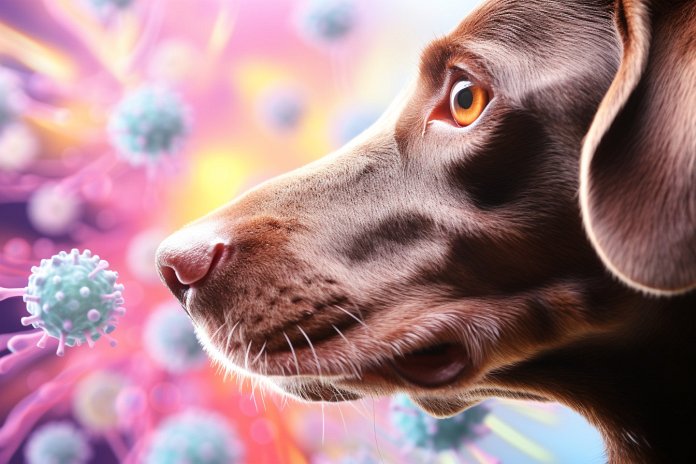
Dogs have a better sense of smell than humans, and they may even be able to sniff out cancer in humans. This is due to the fact that dogs have 25 times more smell receptors than humans, which enhances their smelling abilities by 100,000. Additionally, a dog’s brain is dominated by its olfactory cortex, which is 40 times larger than a human’s. In this article, we will explore how dogs’ incredible sense of smell allows them to detect cancer in humans.
Signs Dogs Can Smell Cancer
There have been documented cases where dogs have detected cancer cells in humans. When a dog smells cancer, they may nuzzle and sniff the affected area, lick it, and fixate their eyes on the person. Dogs may also exhibit unusual behavior, such as increased attentiveness, anxiety, jumping on the person, and nudging the area where cancer cells are present.
Body Language
If your dog detects something abnormal about your smell, they may display the following signs: being alert, jumping up, sniffing, raising their ears, and licking.
Other Signs
Other signs that your dog may give if they have detected cancer in you include: nudging or nuzzling the area, showing obsession with the area, and having wide eyes.
History of Dogs Smelling Cancer
The notion that dogs can detect cancer was first suggested in 1989 in a medical journal called The Lancet. In subsequent years, there were occasional publications on this topic. In 2004 and 2006, two studies showed promising results in cancer detection through urine samples. The 2006 study demonstrated 99% accuracy in detecting lung cancer. In 2011, a study revealed promising results in using breath samples for cancer detection. In 2015, dogs were reported to be able to detect bladder, breast, melanoma, and lung cancer, with a 93% success rate in training them to identify cancer. In 2016, actress Shannon Doherty shared that her dog had detected her breast cancer before doctors diagnosed it. Currently, the British NHS is conducting the first clinical trial to investigate dogs’ ability to smell cancer cells.
Science Behind Dogs Smelling Cancer Cells
Numerous studies have shown that dogs can detect cancer through breath samples. Scientists are now working on developing a breathalyzer test that can match the accuracy of a dog’s nose. Currently, dogs are the only ones able to detect cancer in its early stages. Italian researchers conducted a study that trained dogs to detect prostate cancer from urine samples with 98% accuracy. In a subsequent study, these trained dogs successfully identified specific volatile organic compounds related to prostate cancer from urine samples of 677 participants. The accuracy rate was 88.2% when compared to surgical pathology reports.
Training a Dog to Smell Cancer Cells
Cancer cells emit an odor that can be detected in bodily fluids and breath. To train a dog to smell cancer, they need to be exposed to hundreds of samples. The dog should have exceptional scent-detecting abilities and a calm and focused temperament. Training involves a reward system when the dog correctly identifies a sample. Follow these steps to train a dog to smell cancer:
1. Play with your dog using a toy as a reward for simple compliance commands.
2. Introduce a scent wheel with two containers, one with a distinguishable scent like vanilla and the other with water or empty.
3. Reward your dog when they approach the container with the distinguishable scent.
4. Teach your dog to perform an alert, such as sitting, when they identify the scent, and reward them.
5. Only reward your dog with play after they complete the alert and identify the scent.
6. Gradually add more scents to the wheel.
7. Teach your dog to alert with different scents.
8. Provide your dog with samples from cancer patients and reward them when they correctly identify the cancer scent. Ignore false indications.
In conclusion
Dogs’ exceptional sense of smell makes them capable of detecting cancer in humans. Ongoing research aims to develop alternative methods, such as breathalyzer tests, to match the accuracy of dogs in early cancer detection. Training dogs to smell cancer involves exposing them to various samples and using a reward system.
“Unlocking the Power of Canine Noses: How Dogs are Sniffing Out Cancer”

Tips & Things to Know
1️⃣ Dogs have an incredible sense of smell, with 25 times more smell receptors than humans. This heightened sense of smell allows them to detect cancer cells in humans.
2️⃣ If your dog detects something abnormal about your smell, they may display signs such as increased alertness, jumping up, sniffing, raising their ears, and licking the area in question.
3️⃣ Scientific studies have shown that dogs can detect cancer through breath samples with a high level of accuracy. Training a dog to smell cancer involves introducing scents, rewarding identification, teaching alerts, and gradually adding more scents, including samples from cancer patients.
Frequently Asked Questions, Answered ✅
1. Can dogs really smell cancer in humans?
– Yes, dogs have been known to detect cancer cells in humans through their sense of smell.
2. What are some signs that a dog may be able to smell cancer?
– Some signs include nuzzling or licking the area, acting strangely or becoming more attentive, and fixating their eyes on the person.
3. Are there any scientific studies supporting dogs’ ability to smell cancer?
– Yes, there have been numerous studies showing that dogs can detect cancer through breath and urine samples with high accuracy.
4. How are dogs trained to smell cancer cells?
– Dogs are trained using a reward system, gradually introducing scents and teaching them to identify specific scents associated with cancer.
5. Can a breathalyzer test replace dogs in detecting cancer?
– Scientists are currently working on creating a breathalyzer test that can be as effective as a dog’s nose, but to date, dogs are still the most reliable in detecting cancer in its early stages.